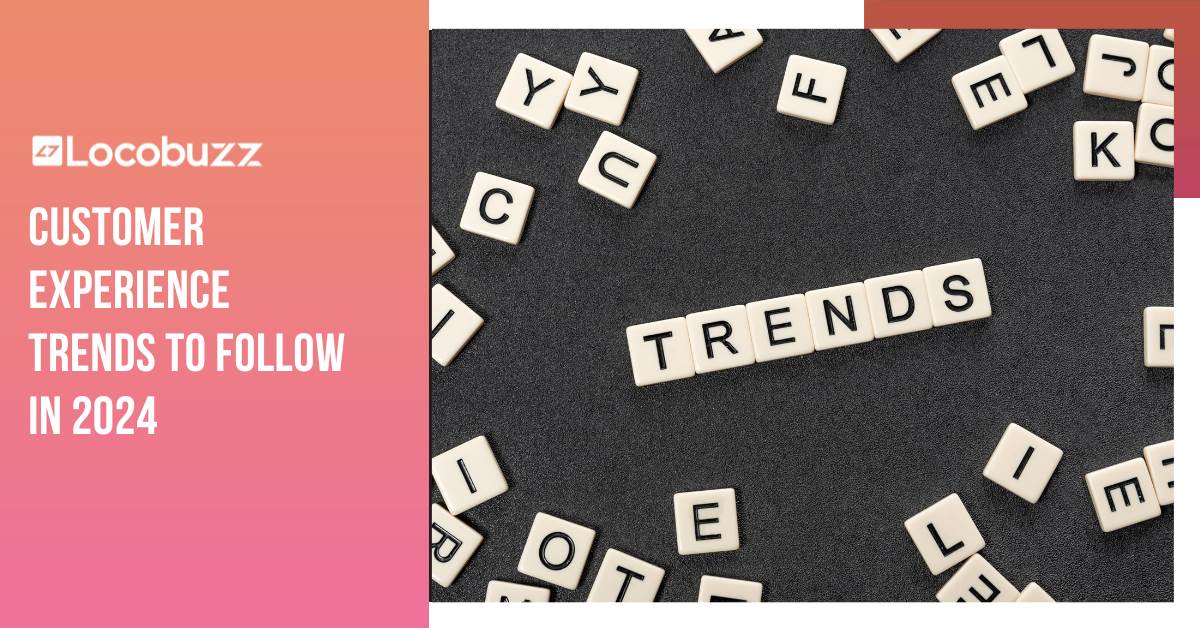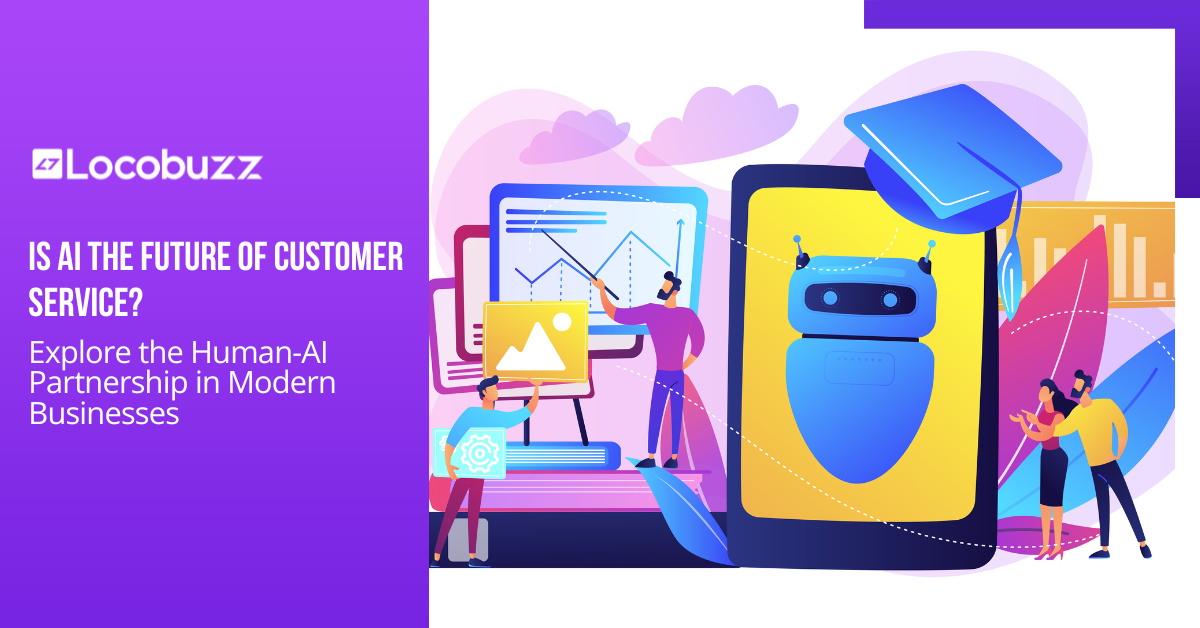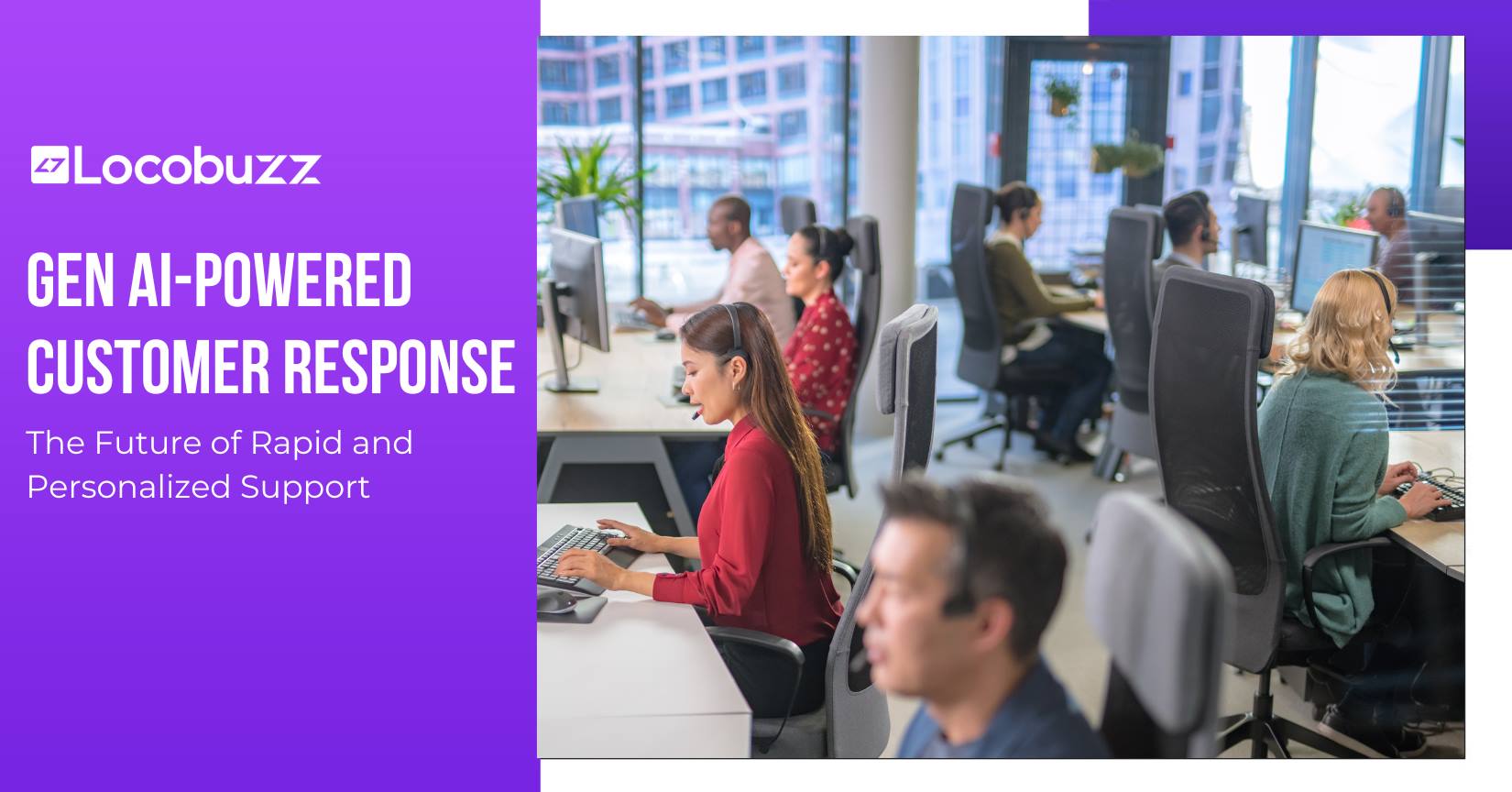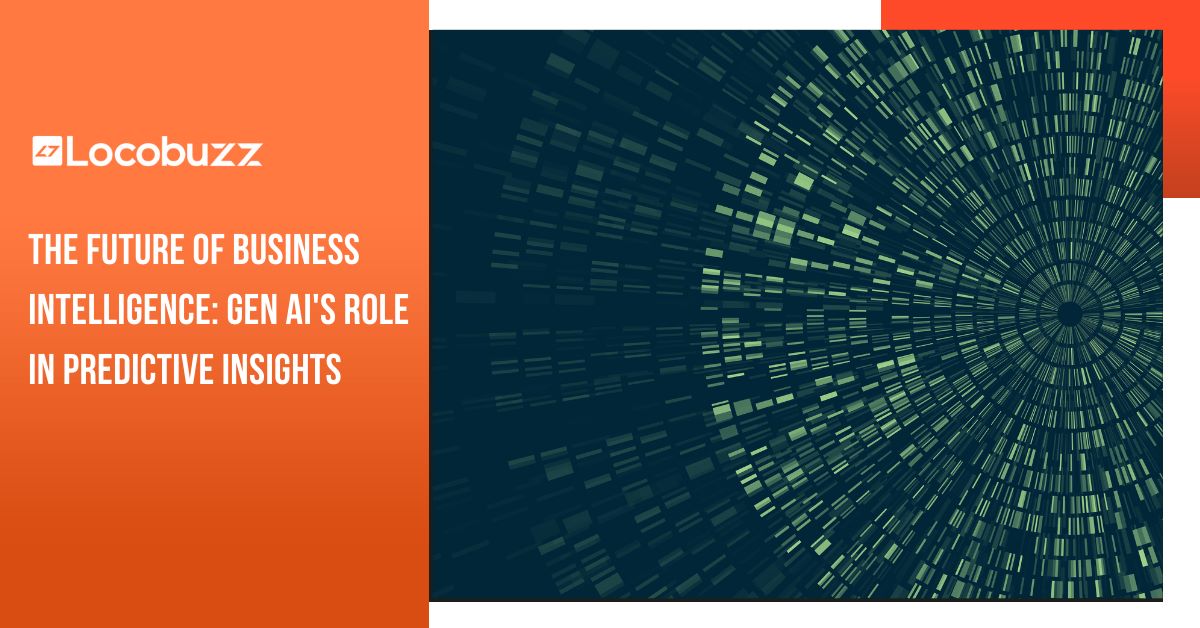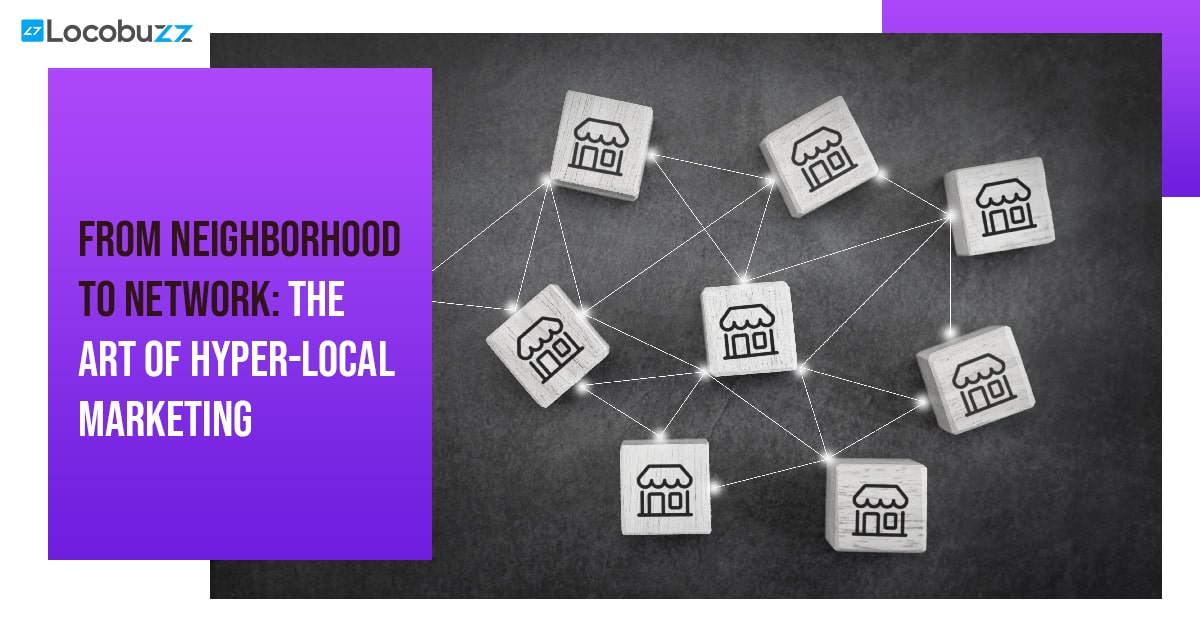Social Media Listening Guide

As of April 2023 approximately 60% of the world’s population use social media and the average daily usage of social media stands at 2 hours and 24 minutes.. A day-to-day social media trend specifies that 1.4 billion people go online on Facebook, and almost 95 million photographs are uploaded on Instagram. These statistics and data play a significant role in curating effective business decisions for companies using social media analytics to increase their customer base and engagement.
By applying social listening tools, businesses may uncover possibilities and hazards by identifying hidden trends and patterns amid the billions of online interactions. This aspect greatly assists the company masterminds in formulating better-informed business decisions.
This article will cover the basics of social listening to help you understand the concept better and apply it to your business.
Table of Contents
What is Social Listening?
Social listening is the process of monitoring and analyzing conversations, discussions, and trends happening on social media platforms. It involves observing what people are saying about a particular brand, product, industry across various social media channels like Twitter, Instagram, and more.
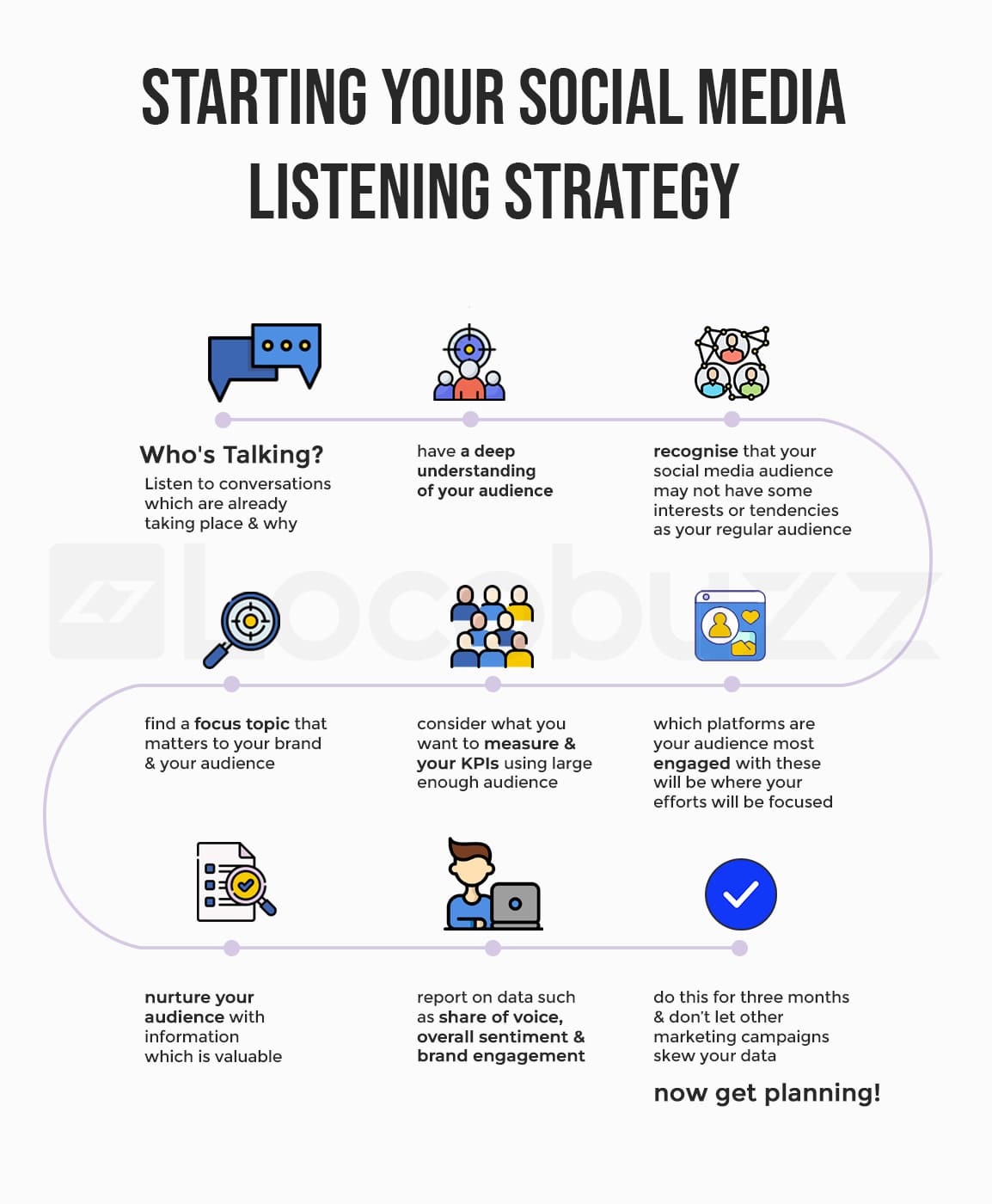
Why is social listening important?
Social listening is important for brands because it allows them to gain a deeper understanding of their target audience and track conversations and mentions of their brand, products, and industry on social media.
Here are some of the listed reasons as to why social listening is important in today’s business landscape.
- Social listening allows you to understand your customers better by gathering insights into their needs, preferences, and pain points.
- It can also help you identify potential leads and business opportunities, as well as track your competition.
- By monitoring social media in real-time, you can quickly respond to any negative sentiment and improve customer satisfaction.
- Social listening will help to build Stronger relationships with your audiences.
- It will help brand marketers create more targeted content based on what the customers needs are.
- Social listening will help in identifying brand ambassadors, influencers and monitor their progress.
By listening on social media platform through a tool like Locobuzz, brands can identify customer complaints, feedback, and preferences in real-time, which can be used to improve customer loyalty.
Overall, social listening is a valuable tool for businesses looking to better understand their market and improve their marketing and customer service efforts.
How Does Social Listening Work?
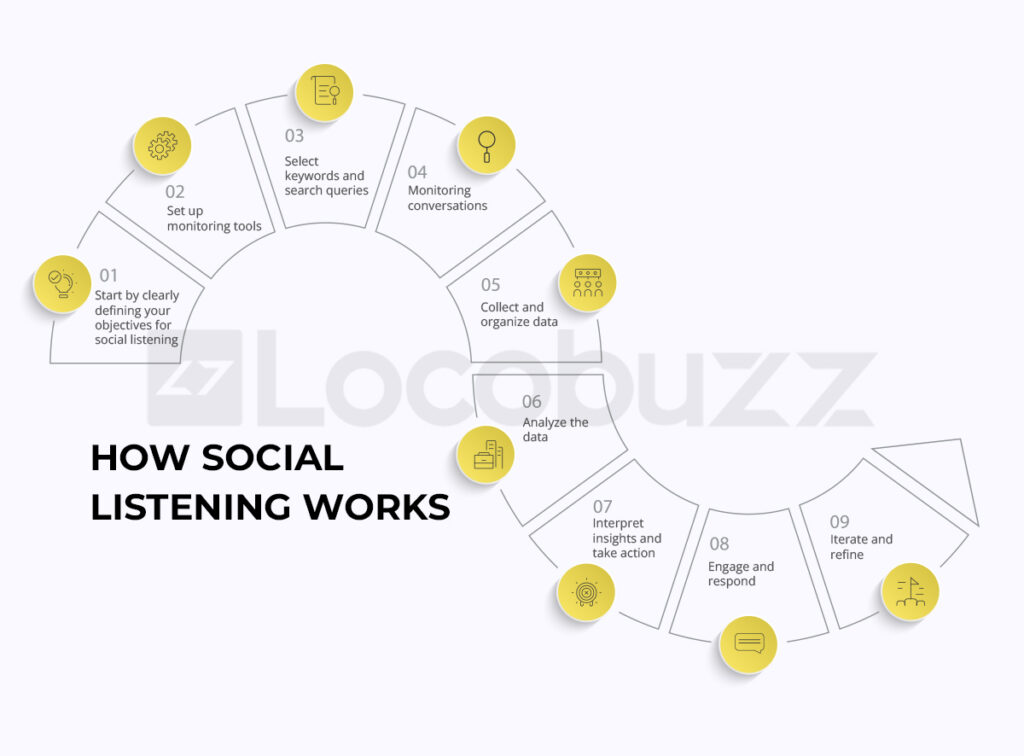
Process of social listening involves using specialized tools to track keywords, collect data, and extract meaningful insights, enabling businesses to make data-driven decisions and engage with their audience effectively.
It’s easy to get lost in the spiral of the internet. Being able to navigate this abyss is a gift. Social Listening aids us in wading through the clutter with the help of keywords. Here, a keyword can be any word or phrase that a customer associates with a brand.
For example, a telecommunication company would rely on keywords like, “Mobile Data”, “Calling”, “Sim Cards”, etc. Keywords are used to filter tweets or posts. This makes it easy to reach customers & segregate posts into positive, neutral, and negative categories.
Associating keywords to terms important for your brand; such as product & brand names, tag lines, etc. enhances filtration further.
Lets Dive into each pointer that was shown in the above image to understand how social listening works
1. Clearly defining objectives for social listening: Begin by identifying the specific goals you want to achieve through social listening.
This could include understanding customer sentiment, tracking brand reputation, identifying market trends, or monitoring competitor activities.
Clearly defining your objectives helps focus your social listening efforts.
2. Set up monitoring tools: Choose suitable social listening tools or platforms that allow you to monitor online conversations effectively.
These tools can help you track mentions, hashtags, keywords, and relevant discussions across various social media platforms and other online sources.
3. Select keywords and search queries: Determine the keywords and search queries that are relevant to your brand, industry, or specific objectives.
These keywords will be used to filter and capture relevant conversations during the monitoring process.
4. Monitoring conversations: Once your monitoring tools and keywords are set up, you can start actively monitoring online conversations.
This involves tracking and observing discussions, mentions, comments, and interactions related to your brand or relevant topics.
5. Collect and organize data: As social listening generates a vast amount of data, it’s important to collect and organize it efficiently.
This may involve using software or tools that help aggregate and structure the data for easier analysis.
6. Analyze the data: Analyze the collected data to uncover patterns, trends, and insights. Look for recurring themes, sentiments, emerging topics, or customer preferences. This analysis helps in understanding the context and implications of the gathered information.
7. Interpret insights and take action: Once the data is analyzed, interpret the insights derived from it.
Identify actionable steps or strategies based on these insights that can improve your marketing, customer engagement, product development, or overall business performance.
8. Engage and respond: Social listening is not just about passive observation; it also involves active engagement.
Respond to customer feedback, queries, or concerns that arise during the monitoring process.
Engaging with your audience demonstrates that you are attentive and responsive to their needs.
9. Iterate and refine: Social listening is an ongoing process.
Continuously review and refine your social listening strategies based on the insights and feedback you gather.
Make adjustments, fine-tune your keywords, and adapt your approach to ensure you are consistently extracting meaningful insights.
By following these steps, businesses can effectively leverage social listening to gain valuable insights, enhance their decision-making process, and engage with their audience in a more informed and meaningful way.
How does Social Listening help?
By using specialized social listening tool businesses, and organizations can track and collect data from social media platforms, including blogs, forums, review sites, and social networks.
Once the data has been collected, it is analyzed to identify key themes, sentiments, and trends.
This process allows businesses to better understand and engage with their customers and stakeholders and can be used for a variety of purposes such as customer service, marketing, product development, and reputation management.
Benefits of Social listening
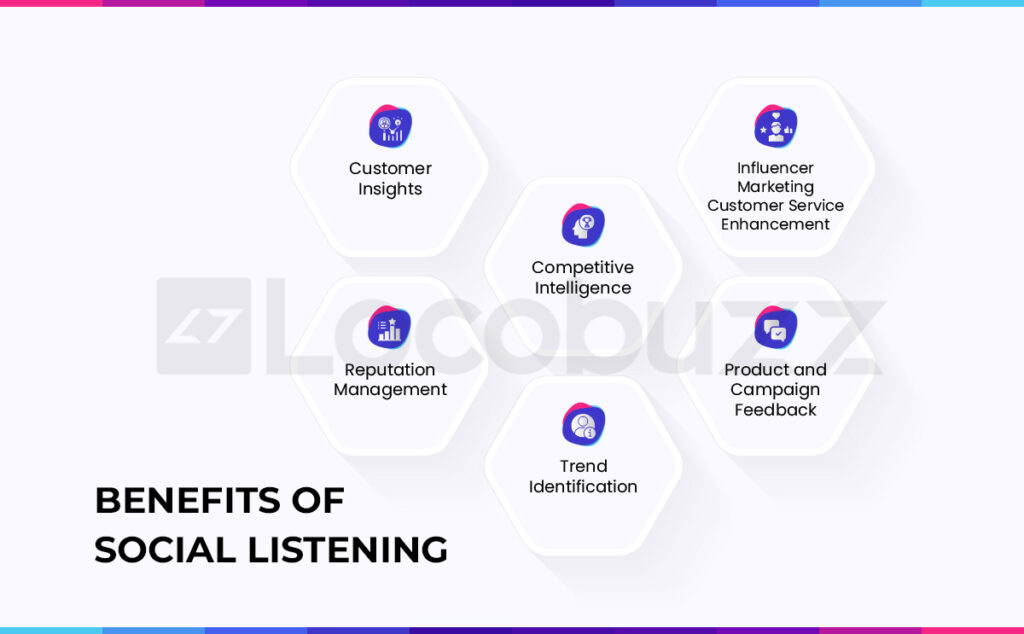
- By monitoring social media conversations, businesses can identify and respond to customer complaints, questions, and feedback in real-time.Quick and proactive responses can enhance customer satisfaction and loyalty.
- Addressing issues promptly can help reduce the number of customer complaints and boost customer retention.
2. Increased Brand Awareness
- Social listening enables businesses to understand what people are saying about their brand, products, and industry.
- Valuable insights from social media conversations can be used to improve marketing and communication strategies.
- Resulting in increased brand awareness and a higher volume of traffic to their website.
3. Enhanced Reputation Management
- Social listening allows businesses to identify and address negative comments or reviews promptly.
- By addressing concerns and taking appropriate actions, businesses can protect and enhance their reputation.
- Proactive reputation management can cultivate trust and credibility among customers.
4. Boosted Sales
- Social listening helps identify patterns and trends in social media conversations related to products and services.
- Businesses gain insights into the needs and preferences of their target audience.
- This information guides the development of more effective marketing and sales strategies, ultimately leading to increased sales.
5. Competitive Intelligence:
- Monitoring competitors and staying informed about industry trends provides a competitive advantage.
- Social listening helps businesses make more informed decisions by analyzing competitor activities.
- Leveraging this information helps identify gaps, discover untapped opportunities, and stay ahead of the competition.
6. Increased Customer Engagement:
- Timely and effective responses to customer comments and feedback foster customer engagement.
- Engaging with customers builds stronger relationships and fosters loyalty.
- Social listening enables businesses to connect with their target audience on a deeper level.
7. Crisis Alerts in Real Time
- If you think about it, the first point-of-contact where you get your daily news happens to be social media.
- Whether it is Twitter talking about an earthquake, or news forums discussing a socio-economic meltdown, social media listening tools have become a huge crisis monitor.
- The ecosystem of risk management in any business can get access to real-time crisis alerts through active social listening platform.
8. Identifying “Negatives” That Impact Brand Image
- Creating a brand image and bettering it over time is pivotal to increasing customer loyalty and gaining advocacy.
- Social listening tools enable brands to identify the “negative” brand voices that could potentially risk brand image.
- This is the first step to understanding ways to improve customer satisfaction that can potentially impact your brand positioning in the market.
9. Quick Response
- 73% of the customers will abandon their carts if the waiting time is longer than 5 minutes.
- One of the most important aspects of managing risks is to keep the consumers engaged and happy with your products and services.
- Social listening tools don’t just help manage the risk to your brand image, but also of long waiting times that consumers may face trying to contact you through traditional
- channels.
- Social networking helps your brand be prompt and cut the risk of customer churn and cart abandonment in the bud.
10. Consumer Satisfaction
- The customer-first approach is necessary today to ensure the sustainability of higher sales and business furtherance.
- Through social listening tools, this risk can be managed by assessing what your customers are saying about your brand to other people.
(Note: You can adapt the content and structure as needed for your specific requirements.)
Here are some reasons to Start Using Social Listening
1. Gain a deeper understanding of your target audience
- Social listening allows businesses to track conversations and mentions of their brand, products, and industry on social media.
- This can help them to gain a better understanding of their target audience, including their pain points, preferences, and behavior patterns.
2. Identify and address customer complaints
- Social listening enables businesses to quickly identify and respond to customer complaints and feedback on social media.
- This can help to improve customer satisfaction and loyalty, and prevent negative reviews from spreading.
3. Monitor your competitors
- Social listening can help businesses to keep an eye on their competitors, track their strategies, and stay informed about industry trends.
- This can give them a competitive advantage and help them to make more informed decisions.
4. Improve your marketing and communication strategies
- By tracking conversations on social media, businesses can gain insights into what resonates with their target audience and what doesn’t.
- This can help them to improve their marketing and communication strategies, and increase their reach and engagement.
Who can use social listening?
Social listening can be used by a wide variety of businesses, organizations, and individuals. Some examples include:
- Companies of all sizes and industries, such as retail, healthcare, finance, and technology, can use social listening to gain insights into their customers, competitors, and industry trends.
- Marketing and public relations professionals can use social listening to inform their campaigns, create more effective messaging, and measure the success of their efforts
- Sales professionals can use social listening to identify leads and opportunities, and to connect with potential customers.
- Customer service professionals can use social listening to respond to customer complaints and feedback, and to improve customer satisfaction.
- Researchers, such as market researchers and academics, can use social listening to gather data and insights for their studies and research projects.
- Non-profit organizations can use social listening to track and respond to conversations about their cause and to gauge the impact of their campaigns.
- Government agencies can use social listening to track public opinion and to monitor for potential threats to public safety.
- Individuals can also use social listening to track their own personal brand, monitor mentions of their name, and keep an eye on the industries they are interested in.
Social listening Vs Social Monitoring
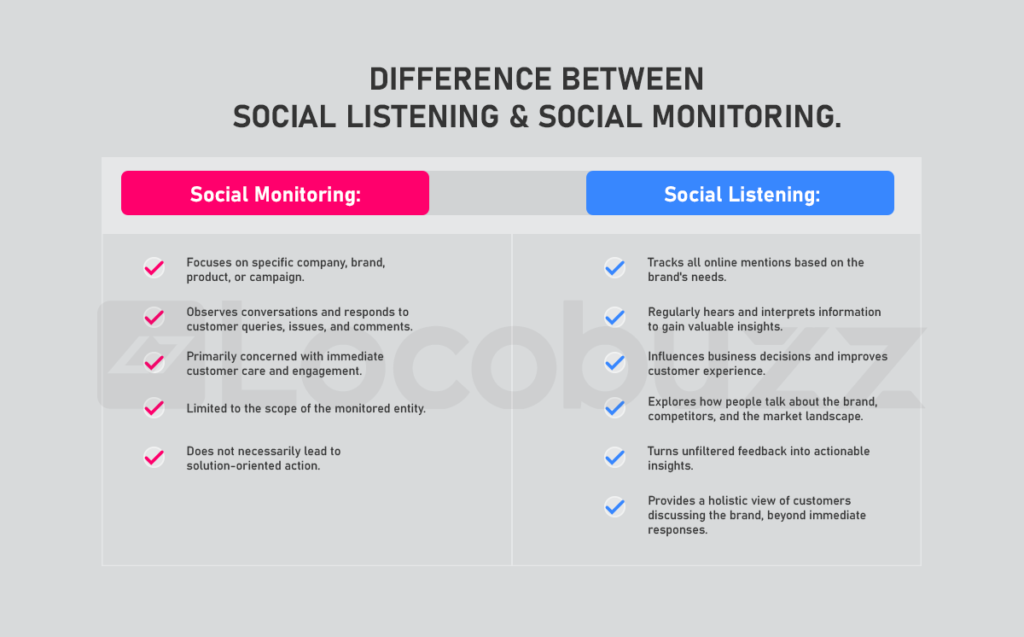
While social monitoring is essential for prompt customer care and engagement, social listening takes it a step further by providing a holistic view of online conversations.
By analyzing and interpreting these discussions, businesses can gain valuable insights that shape strategic decisions and ultimately elevate the customer experience.
Embracing both social monitoring and social listening as complementary practices empowers brands to foster meaningful connections, improve offerings, and stay ahead in today’s dynamic digital landscape.
How Can a Social Listening Strategy Help Your Business?
Social listening allows businesses to understand their customers, track the competition, improve their marketing strategy, identify new opportunities and make informed decisions.
By monitoring social media conversations, businesses can quickly identify and respond to customer complaints, questions, and feedback in real-time, which can improve customer satisfaction and loyalty.
This can also help to reduce the number of customer complaints and increase customer retention.
Social listening also helps businesses to monitor their competitors, track their strategies, and stay informed about industry trends. This can give them a competitive advantage and help them to make more informed decisions.
Additionally, by tracking conversations on social media, businesses can gain insights into what resonates with their target audience and what doesn’t.
This can help them to improve their marketing and communication strategies, and increase their reach and engagement.
Furthermore, social listening can help businesses to identify new opportunities, such as potential partnerships or collaborations, and to gather data and insights that can be used to inform their overall business strategy.
Decoding Risk Management Using Social Listening Tools
Today, social media listening is facilitated by a variety of tools and software that make things simpler. However, it is an art in itself. There is a level of risk involved with social media management and listening which must be accounted for. Let’s understand how you can manage risks with social listening tools.
Managing Risks with Social Listening Tools
For the active social listening practitioners out there, one of the biggest challenges in social media listening is access to quality data. It is a relatively newer discipline and is still undergoing evolution to enable brands to learn more about their consumers in a better way.
The fact that actively scanning social media for potential risks to your business has opened up new avenues of risk management for a company. Let’s look into that in more detail.
Crisis Alerts in Real Time
If you think about it, the first point-of-contact where you get your daily news happens to be social media. Whether it is Twitter talking about an earthquake, or news forums discussing a socio-economic meltdown, social media has become a huge crisis monitor.
The ecosystem of risk management in any business can get access to real-time crisis alerts through active social networking and keeping tabs on relevant hashtags.
Analytics, Reporting, Forecasting, Predictions
The social listening tools today have become “intelligent” by gaining processing and computing power throttled by AI/ML technologies. This has made it easier for businesses to make sense of a high volume of unstructured data by synthesizing insights that provide a better view of:
- Brand image among the target audience
- Demand forecasting based on customer response on social media
- Predictions for a possible risk based on the customer’s voice
Knowing this information beforehand helps with preparedness.
Identifying “Negatives” That Impact Brand Image
Creating a brand image and bettering it over time is pivotal to increasing customer loyalty and gaining advocacy. Social listening tools enable brands to identify the “negative” brand voices that could potentially risk brand image.
This is the first step to understanding ways to improve customer satisfaction that can potentially impact your brand positioning in the market.
Quick Response
73% of the customers will abandon their carts if the waiting time is longer than 5 minutes.
One of the most important aspects of managing risks is to keep the consumers engaged and happy with your products and services. Social listening tools don’t just help manage the risk to your brand image, but also of long waiting times that consumers may face trying to contact you through traditional channels.
Social networking helps your brand be prompt and cut the risk of customer churn and cart abandonment in the bud.
Consumer Satisfaction
A business exists because it has customers and clients. The customer-first approach is necessary today to ensure the sustainability of higher sales and business furtherance. The risk of losing customers to lower CSAT scores is too high to ignore.
Through social listening tools, this risk can be managed by assessing what your customers are saying about your brand to other people.
A Look at Locobuzz's Social Listening Platform
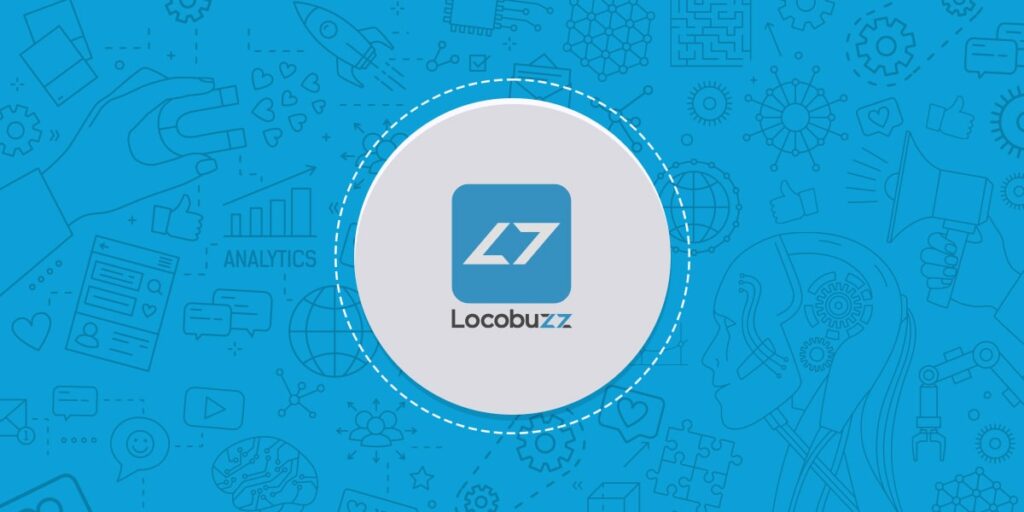
Locobuzz is the highest-rated social listening platform today because of its Engaging, Conversive, and Immersive Brand-User Experience.
With Locobuzz, you have the most impactful understanding of what your customers want, need, and require.
It provides a meticulous understanding of the impact your brand’s Social Media performance is having on clients and users.
Understanding Brand Performance is key, and that’s what Locobuzz strives for making it one of the best social listening tools out there in the market.
Locobuzz implements social monitoring to provide a brand’s Social Mentions from across Social Media on a Single View Platform.
It gives real-time insights to understand customer behavior & social conversations about the brand helping the business take instant action.
This AI-Powered tool has advanced Machine Learning capabilities that present Social Mentions in a categorized fashion so you strategically handle that data.
Locobuzz has the benefit of Investment Efficiency – it limits your expenses on Customer Experience (CX) and gives returns on investment making it a 360-degree digital brand, CX, and marketing suite.
Features
- Social listening: Locobuzz offers real-time understanding of customers, competitors, campaigns, and influencers through the power of modern social listening.
- Insights and actionable data: It captures trends, market shifts, and critical social data to derive actionable insights that improve brand health, strategies, and overall digital presence.
- Workflow management: Easy-to-use workflows help manage customers with increased responsiveness and effective engagement.
- Seamless data-inflow: The Locobuzz CX platform streamlines data-inflow, assigns cases, and manage tasks seamlessly while focusing on increasing engagement productivity.
- Automated reporting and publishing: Versatile, flexible and automated reports, DIY Analytics Reports, Comparison Benchmarking and CSD ID etc, which helps to measure, compare, and study the brand’s ecosystem and crafting a powerful marketing roadmap for the future. The platform also allows the user to schedule, preview, and publish communications across all social channels from a single interface.
In a single-view, Locobuzz helps brands acutely measure brand insights, customer behaviour, competitor insights and performance analytics across all key digital channels to give empowering business insights on a unified CX management platform. Explore the platform or check the video below on why choose Locobuzz.
Real-time monitoring
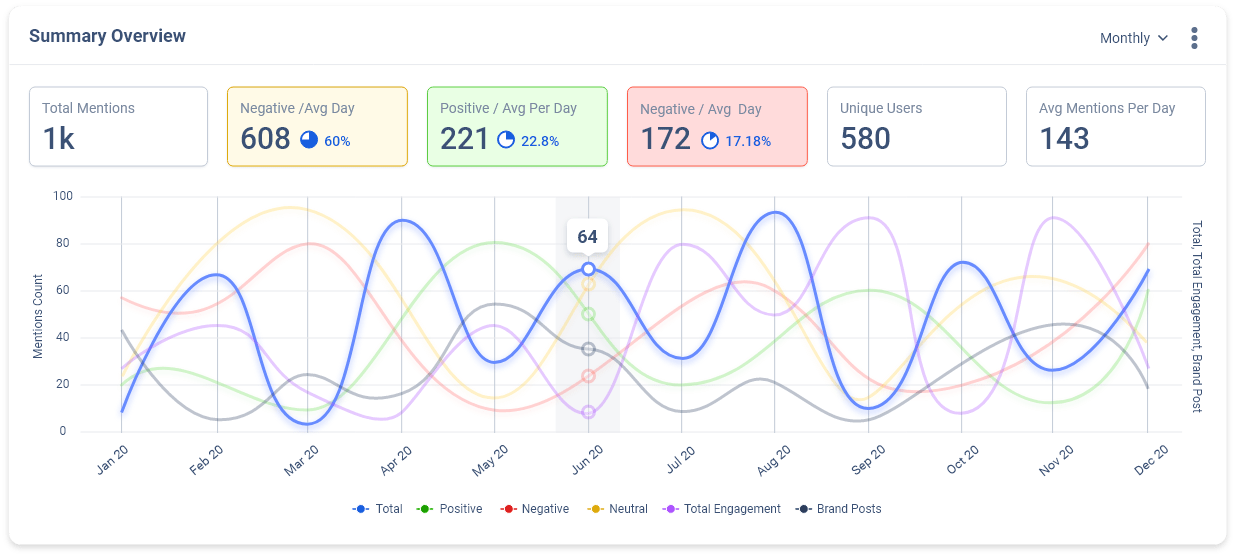 Locobuzz’s platform allows businesses to monitor social media conversations in real-time. This means that they can stay on top of brand mentions and customer feedback as they happen, enabling them to respond quickly and effectively.
Locobuzz’s platform allows businesses to monitor social media conversations in real-time. This means that they can stay on top of brand mentions and customer feedback as they happen, enabling them to respond quickly and effectively.
Sentiment analysis
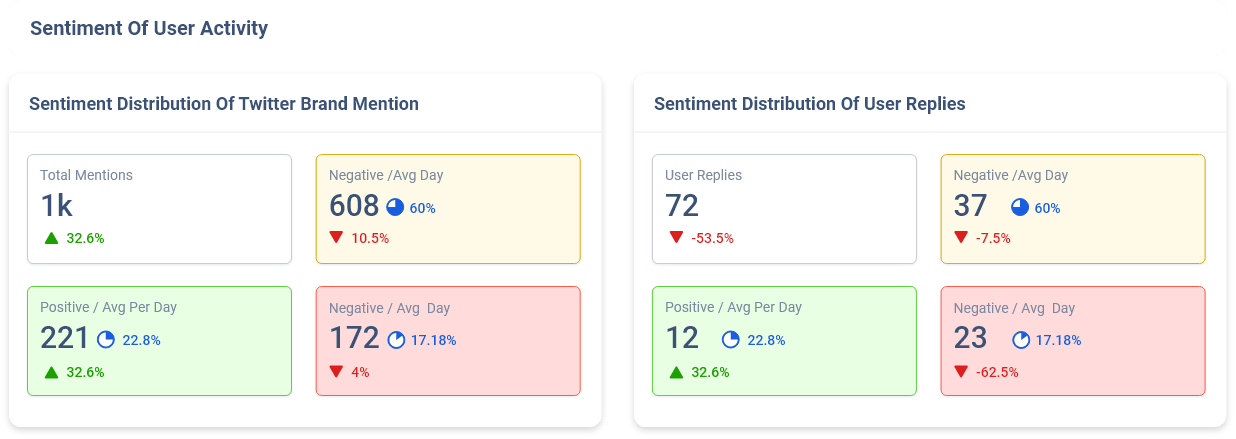 Locobuzz’s platform includes sentiment analysis features that enable businesses to track brand sentiment across social media platforms. This allows businesses to identify areas for improvement and take action to address customer concerns.
Locobuzz’s platform includes sentiment analysis features that enable businesses to track brand sentiment across social media platforms. This allows businesses to identify areas for improvement and take action to address customer concerns.
Competitor analysis
 Locobuzz’s platform includes competitor analysis features that allow businesses to compare their social media performance to that of their competitors. This enables businesses to identify areas where they can improve their social media strategy and stay ahead of the competition.
Locobuzz’s platform includes competitor analysis features that allow businesses to compare their social media performance to that of their competitors. This enables businesses to identify areas where they can improve their social media strategy and stay ahead of the competition.
Emotion cloud
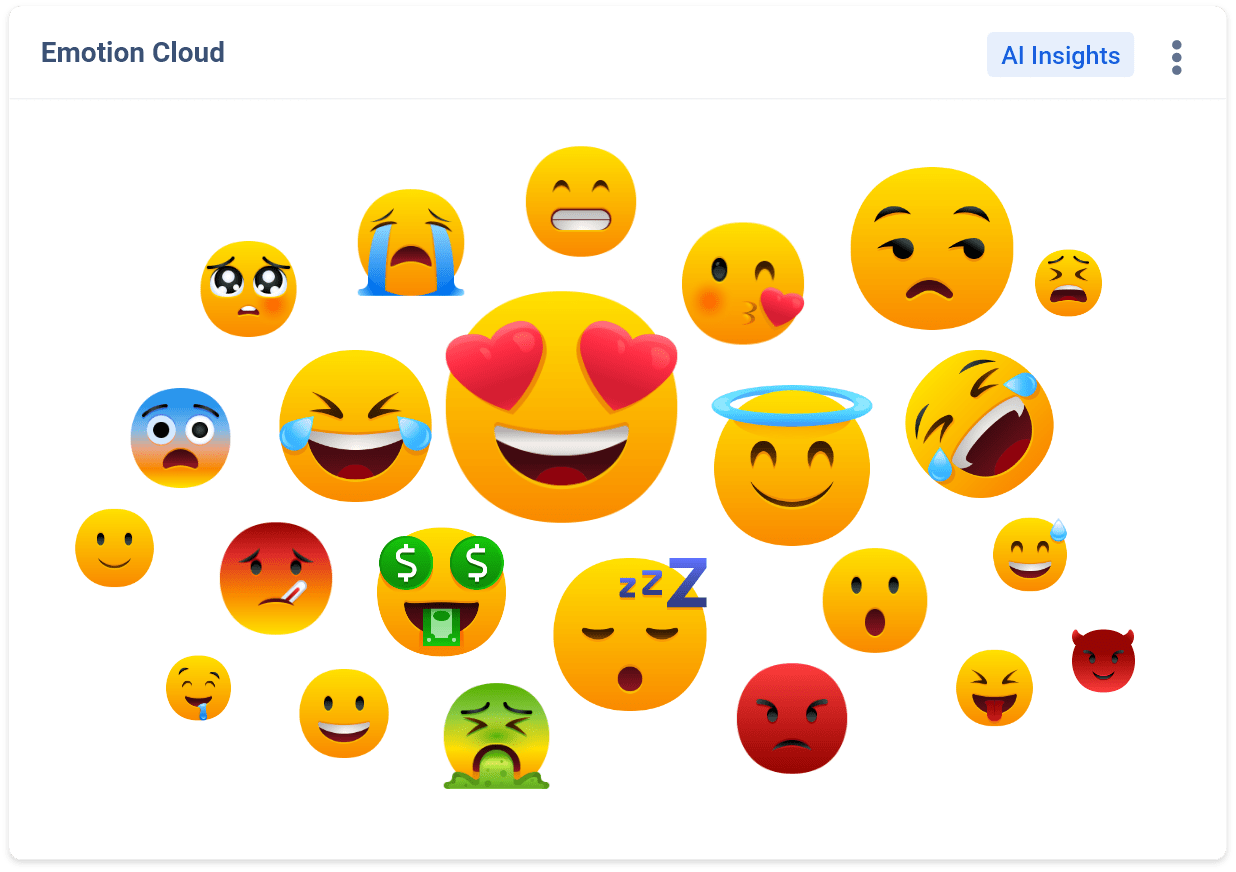
In addition to sentiment analysis, Locobuzz’s platform includes an emotion cloud feature that analyzes social media conversations to identify the emotions being expressed by customers.
This allows businesses to gain a deeper understanding of how their customers are feeling and take appropriate action to address their needs.
The emotion cloud provides a visual representation of the most frequently used emotional keywords in social media conversations, making it easy for businesses to identify and address areas where customers are expressing negative emotions.
By leveraging the emotion cloud feature, businesses can not only track sentiment, but also understand the underlying emotions driving that sentiment.
This can help businesses improve their customer experience by addressing the root cause of negative feedback and enhancing positive experiences.
With real-time monitoring, sentiment analysis, competitor analysis and emotion cloud features, businesses can gain a deeper understanding of customer sentiment, identify areas for improvement, and take action to enhance customer satisfaction and loyalty.
By leveraging Locobuzz’s social listening platform, businesses can stay ahead of the competition and build strong, lasting relationships with their customers.
Strategic Advantages of Leveraging Social Media for Business Growth.
Monitoring brand health and growth
Social listening helps in deconstructing the general perception of your brand and product/service.
It serves as a feedback loop that helps you track the brand’s current position, growth potential, and progress.
Based on such data-driven insights, it is easier for businesses to mold public opinion and manage their online reputation.
There are brand monitoring tools and social media management tools that continuously carry out these actions.
Engage with your customers
Social media has emerged as a tool for businesses to stay responsive and relevant to enhance customer experience.
However, such an approach is possible when you use social listening tools to understand customer sentiments and craft high-value, engaging content.
Discover new market opportunities
If you are looking to break into a new market vertical, you can leverage social listening and let the target audience do all the legwork for you.
Social listening offers a unique customer’s perspective on their pain points, using which you can innovate and capitalize on various windows of opportunities to diversify your product or services.
Increasing customer acquisition and retention
As customers wield the ultimate power of dictating the dos and don’ts of businesses, listening to them can help improve products/services.
Further, it sets the tone for customer expectations that you can use as the benchmark for delighting your customers.
Aligning business strategies with customer expectations will help businesses acquire new customers and retain old ones.
Analyzing competition
Social media platforms are a level playing field for various brands. It acts as a pivoting point for both – young startups and established enterprises to charm their customers.
And as everyone battles it out on the same platform, brands can track and analyze the performance of their competition.
You can use social listening tools to understand why your customers prefer your competition, what are the various marketing strategies that yield success, how are their offerings distinct from that of your own – and so on.
Conclusion
In conclusion, social listening is a valuable practice for businesses seeking to understand their customers, competitors, and the market as a whole.
By actively monitoring and analyzing social media conversations, businesses can gain deep insights, refine their strategies, manage their reputation, and ultimately foster meaningful connections with their target audience.
Embracing social listening as part of their overall digital strategy can lead to enhanced customer experiences, improved decision-making, and a competitive edge in today’s social media-driven landscape.
Visit Locobuzz, a unified platform to help you with your business’s social media monitoring activities.

